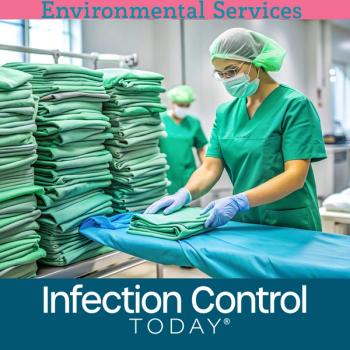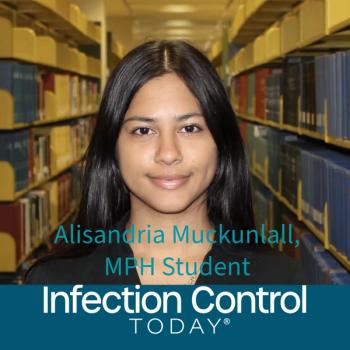
Infection Prevention Buy-In is Essential to Antibiotic Stewardship Efforts
By Kelly M. Pyrek
Earlier this year, professional societies updated a joint position paper underscoring the synergy of infection prevention programs and antibiotic stewardship programs.
“The issues surrounding the prevention and control of infections are intrinsically linked with the issues associated with the use of antimicrobial agents and the proliferation and spread of multidrug-resistant organisms,” says Mary Lou Manning, PhD, CRNP, CIC, FSHEA, FAPIC, lead author of the paper published concurrently in the American Journal of Infection Control and Infection Control and Hospital Epidemiology. “The vital work of IPC and AS programs cannot be performed independently. They require interdependent and coordinated action across multiple and overlapping disciplines and clinical settings to achieve the larger purpose of keeping patients safe from infection and ensuring that effective antibiotic therapy is available for future generations.”
The joint position paper, endorsed by the Association for Professionals in Infection Control and Epidemiology (APIC), the Society for Healthcare Epidemiology of America (SHEA), and the Society of Infectious Disease Pharmacists (SIDP), updates a 2012 paper that affirmed the key roles of infection preventionists (IPs) and healthcare epidemiologists (HEs) in promoting effective use of antimicrobials in collaboration with other healthcare professionals. The new paper highlights the synergy of IPC and AS programs, including the importance of a well-functioning IPC program as a central component to a successful AS strategy.
“It is important that all clinicians depend on evidence-based IPC interventions to reduce demand for antimicrobial agents by preventing infections from occurring in the first place, and making every effort to prevent transmission when they do,” says 2018 APIC president Janet Haas, PhD, RN, CIC, FSHEA, FAPIC. “IPC and AS programs are intrinsically linked, making effective collaboration essential to ensure patient safety.”
The authors acknowledge that successful AS programs require a significant investment on the part of the healthcare facility. As Manning, et al. (2018) explain, " AS programs have been shown to improve patient outcomes, reduce antimicrobial agent-related adverse events, and decrease AMR. To date, primary strategies include prescriber preauthorization and prospective audit and feedback, with supplemental strategies such as guidelines and clinical pathway development, intravenous-to-oral conversion protocols, limiting inappropriate culturing, and provider education. Changing practices and prescribing patterns and learned behaviors of physicians, nurses, pharmacists, and other healthcare providers will take time and investment, but is critical to affecting a long-term solution to the rise of AMR and CDI infections. It is equally important that all clinicians depend on evidence-based IPC interventions to reduce demand for antimicrobial agents by preventing infections from occurring in the first place, and making every effort to prevent transmission when they do. IP and HE leaders are credible IPC subject-matter experts with additional social and behavioral skills to effectively engage the different professional disciplines to promote, implement, support, sustain, and evaluate IPC strategies across practice settings-many of the same skills needed by those leading AS programs."
The authors urge healthcare leaders to prioritize IPC and AS as part of wider patient safety initiatives and recommend that IPC and AS leaders collaborate in communications to the C-suite. “Given the synergy between AS and IPC programs, IPC and AS program leaders should seize every opportunity to benefit from each other’s expertise and organizational influence and partner when making the case for program support and necessary resource allocation to clinical and administrative leadership.”
"As nursing students, nurses are taught to fully understand the reasoning and nuances behind why their patient is taking a certain medication, including antibiotics," says infection prevention consultant and paper co-author Steven J. Schweon, RN, MPH, MSN, CIC, HEM, FSHEA, FAPIC. "This continues after licensure and interfaces with antibiotic stewardship. Before administering the antibiotic to the patient, the nurse must understand why this particular agent is being ordered. What are the patient’s signs, symptoms, and culture results? Are there any antibiotic allergies? Does the patient have a history of being colonized with a multidrug-resistant organism (MDRO)? Is the dosing correct, is the duration of therapy appropriate, can the medication be given orally instead of intravenously? Is the patient’s condition and treatment plan correctly communicated during care transitions? Can the antibiotic be discontinued? Can we initiate active monitoring and defer on the antibiotic? Daily, as patient advocates, nurses must be cognizant of all these basic issues and monitor the patient’s condition. In my view, this is non-negotiable."
Schweon adds, "Infection preventionists continue to be fully invested with patient safety, including antibiotic stewardship activities. Fully leveraging AS activities can ensure less antibiotic use, less antibiotic resistance and MDRO development, and less adverse events such as C. difficile. Resultantly, this will lead to optimal patient outcomes, a target that all IPs strive for."
Regarding the cultivation of nursing and infection prevention champions that are essential for the support of AS programs, "Champions for antimicrobial stewardship or other healthcare issues are always best identified by looking for people who are passionate about the subject and have at least some credibility among their peers," says paper co-author Frank Myers, III, MA, CIC, FAPIC, assistant director of infection prevention and clinical epidemiology for UCSD Health. "One mistake many people make is going back to the people they have worked with in the past and been with whom they have been successful. The nurse who is passionate about reducing surgical site infections may not have that same level of passion over antimicrobial stewardship. So, pick those nurses you know care passionately about medication education and MDROs and have them involved in your initial efforts.
Time-starved and overburdened, many IPs may hesitate to add AS-related duties to their responsibilities; however, Myers says most IPs have already been working in this arena. "As with any perceived new role there is concern and cries of, 'I can’t do one more thing,'" he says. "But this isn’t really a new role. In the days before the electronic medical record it was routine at some institutions that if a lab value wasn’t critical, the nurse would tell the physician that the patient had new lab results and review them. Now, we are setting the expectation that when rounding with the physician, the nurse is to help initiate antibiotic time-outs, assist in performing antibiotic reconciliation during patient transitions of care, and educate patients and families about safe and appropriate antibiotic use. If you look at what we now ask in patient satisfaction surveys, healthcare organizations have been asking patients for a while if we explained their medications to them. So, these roles aren’t necessarily new, they just need to be a bit more defined and routinized."
Myers adds, "As for recruiting IPs to antibiotic stewardship again, IPs have been playing a role whether we have recognized it or not. We have been measuring the outcomes of poor antimicrobial stewardship for a long time. A MRSA case or C. difficile or CRE or ESBL case is often an outcome of poor antimicrobial stewardship. And frankly, with some state laws or accrediting bodies listing IPs as expected members of an antimicrobial stewardship team, the word 'recruiting' is less important as many IPs find themselves officially drafted onto the teams. But most IPs know a good antimicrobial stewardship program in their facility means fewer cases of multidrug-resistant organisms."
The three societies present their position against a backdrop of increased awareness of antimicrobial resistance among healthcare providers, policy makers, and the public, and national action plans and forums designed to address the issue, which emphasize the important role of IPC programs in advancing successful AS interventions across the continuum of patient care.
“IP and HE leaders are IPC subject matter experts who are also trained with social and behavioral skills that allow them to effectively engage with different professional disciplines within healthcare to promote, implement, evaluate, support and sustain IPC strategies across practice settings. These are similar skills as those exhibited by leaders of successful AS programs,” says Keith Kaye, MD, MPH, FSHEA, president of SHEA.
APIC, SHEA, and SIDP support the CDC Core Elements of AS framework and identify the synergy of IPC and AS within each element of the CDC recommendations. In addition, the three societies believe that microbiology laboratory staff members and clinical microbiologists play an essential role in successful IPC and AS programs.
As Manning, et al. (2018) explain, "The CDC identifies core elements associated with successful AS programs-seven elements for hospitals and LTC facilities, and four elements for outpatient facilities-and provides a framework for implementation."
Core element No. 4, requires action, and as Manning, et al. (2018) add, "Although IPs and HEs may not be involved in preauthorization or prospective audit and feedback interventions, they do engage a diverse range of clinical disciplines across practice settings in HAI prevention. IPs have substantial contact with bedside nurses, often together reviewing patients who develop HAIs as part of routine daily activities. They can leverage these strong collegial relationships to influence and facilitate nursing’s supporting role in initiating antibiotic timeouts, performing antibiotic reconciliation during patient transitions of care, and educating patients and families about safe and appropriate antibiotic use. For example, a recent study found that nurse prompting of antimicrobial review during daily rounds can lead to significant reduction in antimicrobial agent use, providing another mechanism of sustaining antimicrobial awareness. Additionally, IPs and HEs often participate in unit-based safety teams (e.g., the Comprehensive Unit-Based Safety Program) and can facilitate an interprofessional, unit-based discussion of AS needs by inviting relevant AS team members to join the meetings. Furthermore, collaborative efforts to have the stewardship team contact the IPC team when they identify and/or approve antibiotic therapy for patients with infections caused by certain MDROs, and IP assistance in training bedside nurses in appropriate culture techniques are examples of how IPs and stewards can expand the capacity of both teams. Similar to IPC interventions and actions, flexibility and tailoring AS approaches to local needs is essential."
“IPs and HEs engage a diverse range of clinical disciplines across practice settings in HAI prevention. The work of physician and pharmacist AS program leaders is greatly enhanced by the support of other key groups, including IPC programs,” says Elizabeth Dodds Ashley, PharmD, MHS, BCPS, Duke University Department of Medicine and president of SIDP.
Myers adds that institutional leadership can help clear barriers to IPs' involvement in AS programs. "No team in a facility on any subject will be successful in an institution where leadership does not remove the barriers to success," he says. "In situations where these kinds of barriers exist, an analysis by the antimicrobial stewardship program identifying impediments to full involvement of all relevant resources needs to be conducted and shared with leadership. Only then can the barriers be removed. And most healthcare institution leadership know the cost of treating an MDRO is more expensive than treating a non-MDRO infection. They also know new broad spectrum antibiotics are more expensive the older more narrow-spectrum antibiotics. And, even a child knows it is more expensive to give an unnecessary antibiotic than not give an unneeded antibiotic. So, the leadership of the facility is very incentivized to remove the barriers to participation in antimicrobial stewardship."
It may take incentives to entice greater IP participation moving forward. "This will be a moment of truth for IPs," Myers acknowledges. "IPs often are confronted by healthcare providers asking why they should do something that is more work (and lowers a patient risk for infection) compared to a shorter process (that puts a patient at greater risk for infection). And we sometimes say, if the patient gets an infection it is a lot more work for you. Well, in this case, if IPs don’t get involved it weakens the antimicrobial stewardship program and that means more MDROs and that means more work for the IP. That and a deep desire for protecting the patient should be ample reason for the IP to be involved in the process."
Myers adds, "Skilled IPs are really stretched to full capacity and we always will be. But the one tool an IP uses every time a new standard or issue comes is the risk assessment. We are always prioritizing and reprioritizing what we do. And I don’t know many acute care IPs that don’t consider MDROs an issue in their institution. So, I have little doubt IPs will become more and more active team members in this endeavor."
Myers says there are additional ways that IPs can help reduce antimicrobial use in an institution. "I think we are seeing more and more studies come out discussing clinical testing stewardship," he says. "When I started out many years ago it wasn’t unusual to see a specimen cup at the nurse’s desk with some brilliant green purple tinged sputum. It would stay there for hours awaiting the physician to round and the nurse would then show the specimen to the physician and state something like, “The patient coughed this up earlier, do we want to culture this?” And the physician without looking at the patient’s WBC or temperature or O2 sats would say, 'Yes' and while the specimen was clinically unimportant and not handled correctly, when the results came back antimicrobial therapy would be initiated. We must be smarter than we used to be. Members of the care team need to act as reminders for each other, hold each other accountable and keep each other informed. This means when a patient has one loose stool let the physician know, but also let the physician know if the patient is on stool softeners. If the patient has resolution of diarrhea and other symptoms before antibiotics are initiated, let the physician know. If a nurse is supposed to get a sample of diarrhea and the patient hasn’t had a bowel movement in 24 hours, every nurse should feel comfortable asking the physician if they still need the test, as this is an appropriate question. With the new PCR tests, we are capable of detecting the presence of organisms, that while pathogenic in sufficient quantities, may also be just colonizers or in some cases just that patient’s normal flora. So, inappropriately ordered tests or poorly gathered specimens probably have a much bigger consequence than in the past. Unless all care providers are only running tests that are currently clinically appropriate, our antimicrobial stewardship will not be as successful as it needs to be."
Reference: Manning ML, Septimus EJ, Dodds Ashley ES, Cosgrove SE, Fakih MC, Schweon SJ, Myers FE, and Moody JA. APIC/SHEA/SIDP Antimicrobial Stewardship Position Paper: Antimicrobial stewardship and infection prevention – leveraging the synergy: A position paper update. Am J Infect Control. Vol. 46, No. 4. April 2018; and Infect Control Hosp Epidem. Vol. 39, No. 4. April 2018.
Newsletter
Stay prepared and protected with Infection Control Today's newsletter, delivering essential updates, best practices, and expert insights for infection preventionists.





